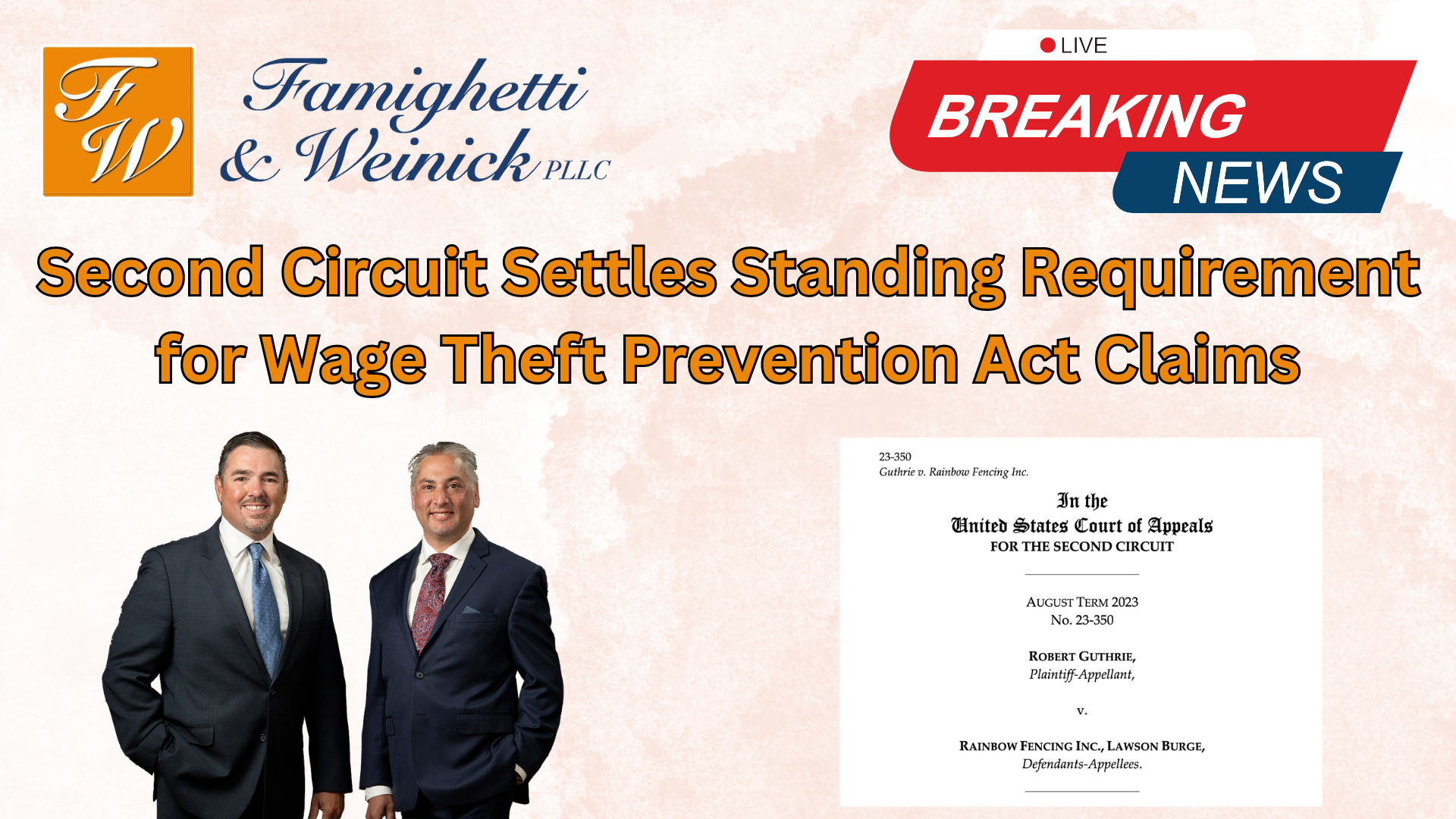- Free Consultation: (631) 352-0050 Tap Here to Call Us
Employees Face New Hurdles for State Law Labor Law Claims in Federal Court

New York Labor Law 195, known as the Wage Theft Prevention Act or WTPA, requires that employers in New York do two things: (1) upon an employee’s hire, the employer must provide the employee with a wage notice, identifying information such as the employee’s regular rate of pay and overtime rate of pay; and (2) when wages are paid, the employer must provide the employee with a wage notice which identifies the calculation of the pay for the pay period, and wage deductions taken. Violations allow employees to sue and to recover up to $10,000 in statutory damages. This is a New York state law, with no federal equivalent.
Because federal and state wage laws frequently overlap in other areas of coverage — such as the requirement to pay non-exempt employees overtime — employees suing employers in New York for improper payment of wages often sue in federal court, asserting violations of both federal and state laws. Employers who violate wage and hour laws, oftentimes also fail to comply with the WTPA, so WTPA claims are usually included with claims alleging improper payment of wages. On August 30, 2023, the United States Court of Appeals for the Second Circuit issued a decision which may limit employees’ ability to bring WTPA claims in federal court. Today’s Long Island employment law blog explains.
Federal courts are courts of limited jurisdiction. This means that they can only hear certain cases as set forth in the Constitution and by law. Generally, federal courts can usually hear cases which involve issues concerning federal law. So, when a victim of wage theft sues an employer, if they want to bring the case in federal court, they sue under the Fair Labor Standards Act (FLSA), which is a federal law. If the employee uses only New York State’s Labor Law, unless some other basis of jurisdiction exists, the case would be dismissed from federal court because without a federal law at issue, the court has no jurisdiction to hear the case.
But, when an employee uses the FLSA, the employee can also bring related claims which arise under state law. This is known as asserting supplemental jurisdiction.
Jurisdiction is not the only bar to determining whether a case or a particular claim in a case can be pursued in a federal court. Article III of the Constitution requires that courts hear only “cases or controversies,” a concept typically referred to as standing. Standing, as interpreted by the Supreme Court, requires that a plaintiff show an actual injury or a concrete harm, in order to bring a case in federal court.
Standing is the issue that’s been waiting for employees asserting New York State WTPA claims in federal court. Some employers have argued and some federal District Courts have agreed (or raised the issue on their own), that employees do not have standing to bring WTPA claims in federal court. The reason offered by these employers and courts is that the WTPA provides for only a monetary damage based on a statutory violation. Based on a 2021 Supreme Court case referred to as TransUnion, where a plaintiff asserts claims seeking money damages based just on a statutory violation, the plaintiff must show a harm distinct from the violation to show standing.
Based on TransUnion, many federal District Courts in New York have dismissed WTPA claims. Others, however, have ruled that a separate injury is not required to be alleged, and have allowed WTPA claims to proceed. This divergence is a perfect storm for an appellate court to rule on the matter and indeed, in Guthrie v. Rainbow Fencing, Inc., New York’s federal appellate court, the Second Circuit, weighed in on the matter.
In Guthrie, the Second Circuit confirmed that TransUnion is the controlling Supreme Court case. Based on TransUnion, the Second Circuit agreed that the courts which require showing of an actual or concrete harm, reached the proper decision. In so doing, the Court rejected the idea that an “informational injury” is sufficient harm. Under the theory advanced by Guthrie, by omitting information which the WTPA requires employers give employees, the employee has sustained an injury sufficient to have standing. The Second Circuit rejected this. In sum, the Second Circuit ruled that employees asserting WTPA claims in federal court must allege a concrete injury in fact.
The Second Circuit has not closed the door entirely though. In fact, the Court specifically explained circumstances which could establish an injury in fact, such as when an inaccurate or non-compliant wage notice prevents an employee from obtaining timely payment of wages. Moreover, the Court also pushed back on District Courts which required a higher showing of injury.
Of course, the decision applies only to WTPA claims in federal court. Cautious employees may decide the Guthrie decision means that they should rely on state claims in state court, instead of federal and state claims in federal court.
Though not outright endorsed by the Second Circuit, in a footnote, the Court alluded to other allegations which might show standing:
- wage statements which did not show full hours worked prevented employee from determining and seeking payment for the precise wages she was owed;
- a misclassified employee showed an injury because she wasn’t told she was supposed to be paid overtime, so she lost the opportunity to advocate for proper payment;
- inaccurate wage statements which did not state a calculation of hours and overtime, prevented the employees from knowing the extent of underpayment of wages.
In sum, the Second Circuit has settled a split in decisions coming out of federal courts in New York about whether standing to assert a WTPA claim requires a showing of concrete injury. It does. But, the Court has not ruled that WTPA claims can never be brought in federal court and the Guthrie decision lays out a blueprint which employees can use to build a WTPA claim which properly satisfies the standing requirement.
If you have questions about the Wage Theft Prevent Act, standing, overtime, minimum wage, or other wage and hour laws, contact an employment lawyer at Famighetti & Weinick PLLC. Our phone number is (631) 352-0050 and our website is http://linycemploymentlaw.com.









